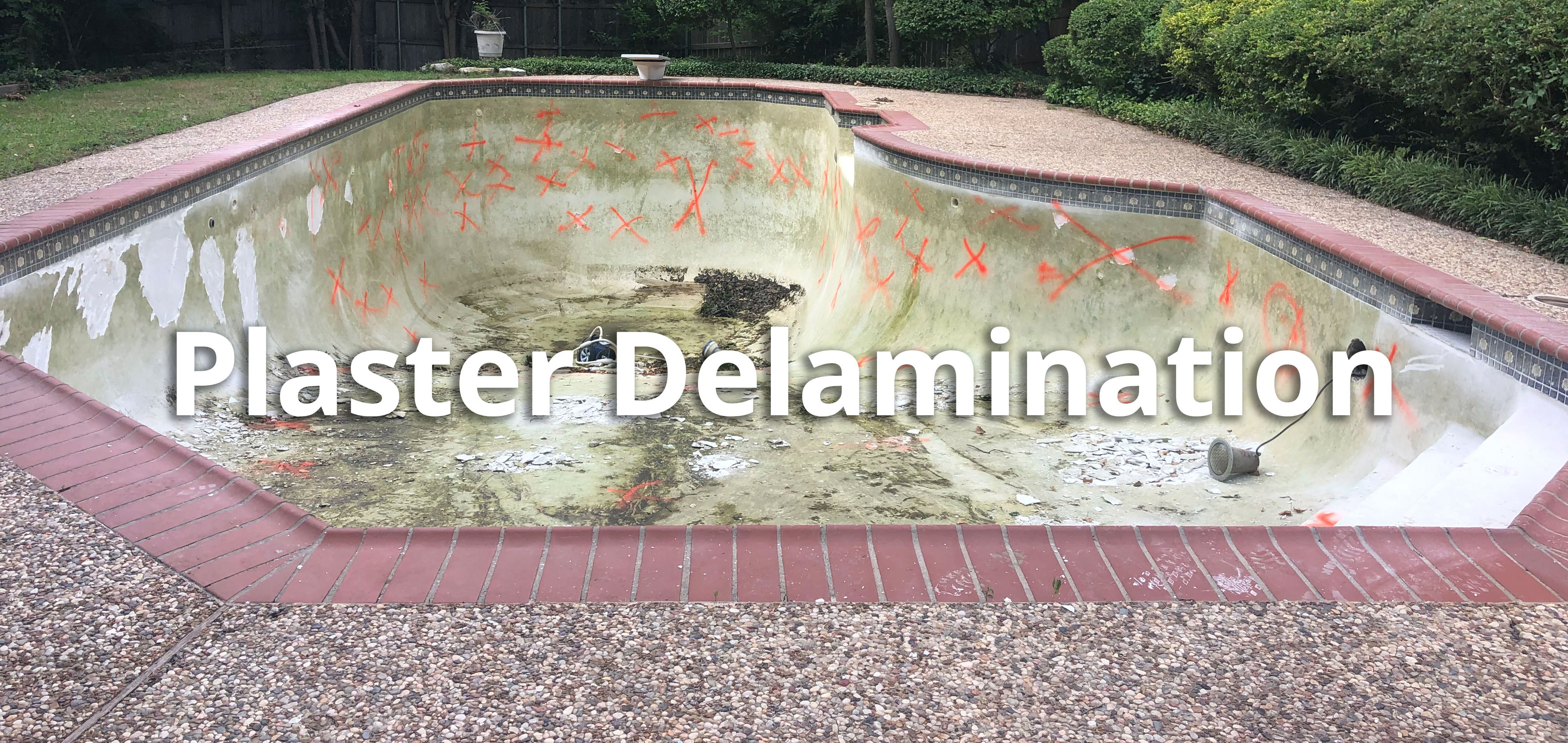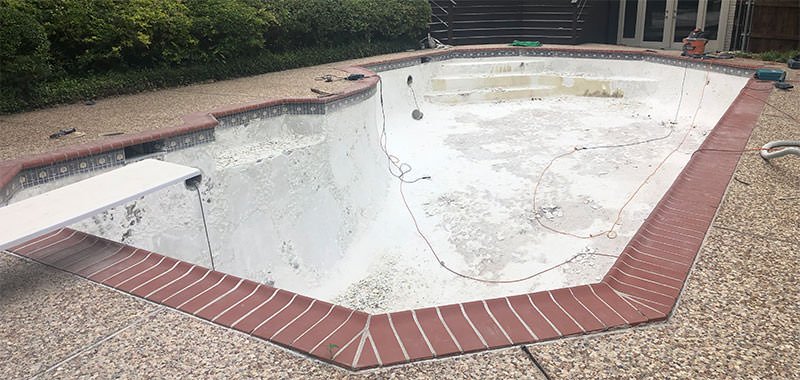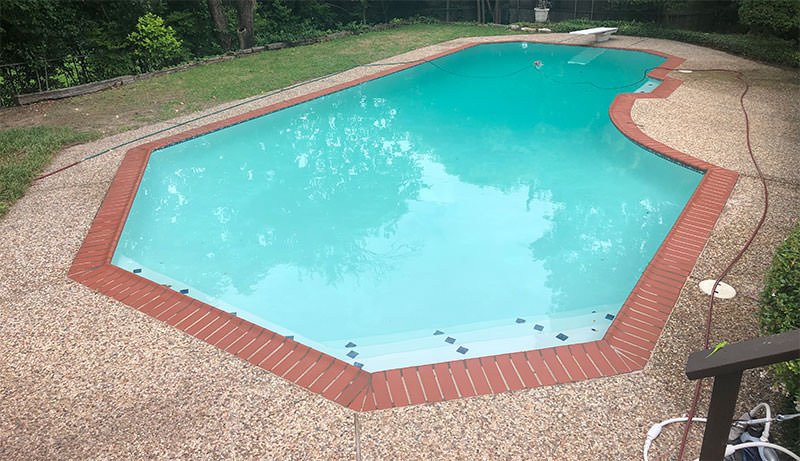It’s no secret that pools require yearlong upkeep in the form of servicing, cleaning, and maintenance, but sometimes, despite the most dedicated care, pools become susceptible to unexpected issues that regular service doesn’t prevent.
One of the most common—and often bewildering—problems that pool owners face is pool plaster delamination.
Never heard of it?
Here’s everything you need to know to identify this unsightly pool concern and how to solve this issue.
What is Pool Plaster Delamination?
You’ve probably seen pool plaster delamination in a pool at some point without knowing what it was. We’ll talk about the causes in the next section, but first, let’s talk about how to identify delamination.
Once you know what to look for, the outward signs are unmistakable: blisters or bubbles that form on the surface of the swimming pool.
These blisters or bubbles are calcium nodules or small buildups of calcium carbonate on the pool surface. They’re easy to recognize because of their strong resemblance to bird droppings.
Calcium nodules are usually round, and they look somewhat like volcanoes when they form on horizontal surfaces. On vertical surfaces, however, they tend to look more like drips or stalactites.
Delamination can occur in small areas two to three inches in diameter, or it can form in wide expanses of three to four feet, or even more.
While delamination formations are generally easy to identify based on the features we’ve already mentioned, another distinguishing characteristic is the color.
Delaminated areas are usually white, though they do sometimes become grey over time. If they absorb other elements, they can be different colors as well, but generally, they’re white.
Pool Plaster Peeling & Popping Off
Delamination also occurs in another form, known as pop-offs.
Pop-offs happen when the volcano-like blisters and bubbles we can see on the pool surface increase significantly in size. Everyday pool use, such as repeatedly stepping on the affected area, or your pool cleaner moving over the blisters, cause these prominent blisters on the plaster to break off from the plaster surrounding it.
Pop-offs resemble large craters.
You may not notice delamination happening until pop-offs occur. The damage becomes much more visible once a pop-off forms and this particular problem is more common in re-plastered pools whose newer surfaces often have trouble bonding to the gunite or concrete walls of your pool.
What Causes Pool Plaster Delamination?
Given the fact that most people who have a pool spend lots of time taking care of it, noticing pool plaster delamination is worrisome—and frustrating. When pool owners see the signs, their first thought is:
“Why is my pool plaster peeling?” or “Why is my plaster changing color?”
The explanation is simple.
Pool plaster delamination occurs when there is a bond failure between the gunite and plaster that covers it. This bond failure creates an air cavity or a void. In and of itself, having a void in your pool is not problematic. You might not even realize you have bond failure if the void doesn’t reach the plaster’s surface.
The problem happens when impact or stress on the plaster allows the void to reach the pool surface via a small pinhole or hairline crack, which are caused when the delaminated plaster experiences structural flexing.
These pinholes and hairline cracks allow water to get behind the pool’s plaster mass and dissolve calcium hydroxide. Calcium hydroxide carbonates into a solid mass that seeps out on the pool’s surface and results in the nodules we see.
Besides impact or stress on the plaster, certain environmental factors such as low humidity and excessive sun exposure or heat before filling the pool may cause this problem.
Ground shifting is another factor that can lead to delamination.
Avoiding Pool Plaster Delamination
What doesn’t cause delamination is pool water chemical balance. It’s also not caused by flaws in your maintenance routine, pool cleaning schedule, or anything else that you do to the pool regularly.
How to Repair Pool Plaster Delamination
Since you didn’t cause it and you don’t see any apparent underlying triggers, any pool owner who sees signs of pool plaster delamination wonders the same thing: will this problem become more severe, and if so, how do you take care of it?
Unfortunately, if you notice delamination in your pool, it’s usually a sign of more nodules to come. Long-term wear and tear can damage the pool’s surface and put you at risk for this problem, but as we said before, it’s not typically caused by something you do to the pool.
Instead, the risk is generally present before you even fill the pool.
Delamination happens primarily due to poor plastering jobs.
Sometimes you can see the effects of shoddy jobs right away, and sometimes they arise as the years go by. The best way to avoid this problem is by doing plastering right the first time.
The bad news is that if you see nodules on your pool, the damage is already done and the situation requires your attention.
Pool Plaster Resurfacing
As you might imagine, dealing with delamination requires you to resurface the pool plaster. We recommend hiring a professional from the Willsha Pools team to complete this treatment for you because there are several ways you can incorrectly resurface that lead you back to the same problem.
If the problem is widespread, you’ll likely need to have your entire pool resurfaced.
It may be disheartening to hear this, but taking care of the problem is vital to ensuring that you and your family enjoy many years of fun in the pool and have a way to cool off in the intense Texas heat.
How Much Does Resurfacing Cost?
The short answer? It depends.
Several factors influence how much your pool resurfacing costs will be. The most important factors are generally the size of your pool, the material you use to fix the surface, and the extent of the damage to the pool’s surface. The need for leak detection or crack repair will also influence the cost.
We know that it’s helpful to have a ballpark figure when budgeting for any pool maintenance or repair. If you know your pool’s measurements, you can get an idea of how much pool plaster delamination repair will cost even before having a consultation by using our pool resurfacing cost calculator.
Contact Willsha Pools For Your Free Quote
When it comes to pools, a lot is going on beneath the surface—quite literally—that makes discovering the issue and knowing how to proceed tricky. If you’ve got concerns about delamination—or any other pool-related problem—our team of professionals have more than ten years of experience and is ready to help you.
Willsha Pools offers free consultations where we assess your needs so we can find just the right solution for you.
Contact us today for your free quote.




